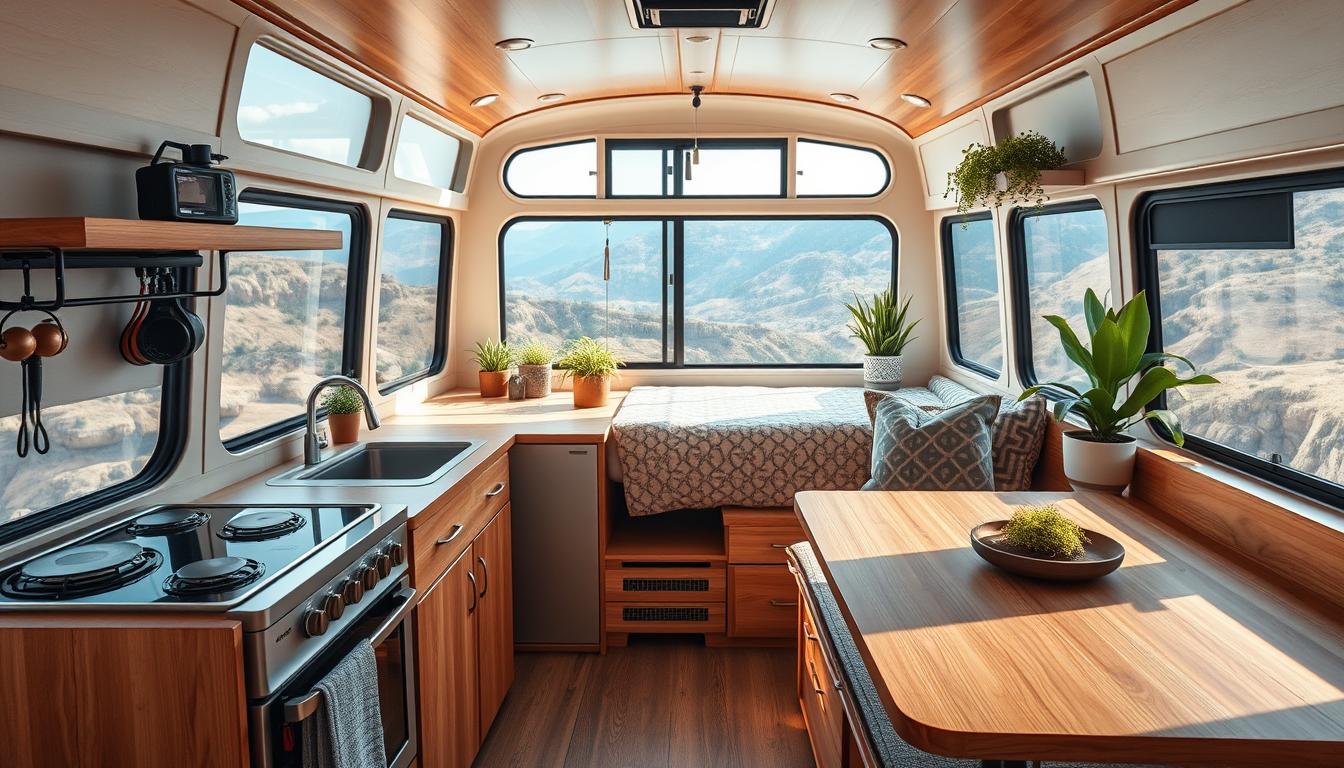Turning a school bus into a tiny house is a thrilling idea. It’s not just about downsizing; it’s about creating a mobile home that’s both stylish and functional. This guide will show you how to pick the right bus and do the necessary renovations. You’ll learn about insulation, plumbing, and design to make your bus home comfortable and chic.
The trend of bus home design is booming, attracting many in the UK and worldwide. A mobile home lets you see the countryside while enjoying home comforts. We’ll explore the conversion process, offering tips and advice to make your journey exciting.
Key Takeaways
- A tiny house bus offers a unique and mobile alternative living experience.
- Bus conversions can be budget-friendly, with costs ranging from £3,000 to £20,000.
- Strategic planning and detailed renovations are crucial for a successful bus home design.
- The converted bus living trend is gaining popularity for its flexibility and creative potential.
- Expert advice and resources are available for those embarking on their bus conversion journey.
Why Convert a Bus into a Tiny Home?
Converting a bus into a tiny home is becoming more popular. People are looking for alternative living spaces and affordable homes. This idea lets them create unique, flexible homes that are different from usual houses.
The Appeal of Mobile Home Freedom
One big reason for choosing a bus home is the freedom it offers. You can travel and live in different places in the UK. It’s not just about living in a small space; it’s about living an adventurous life.
Unlike regular homes, a bus home lets you move around easily. You can meet new people and see new places without being tied down. It’s a way to live life on your own terms.
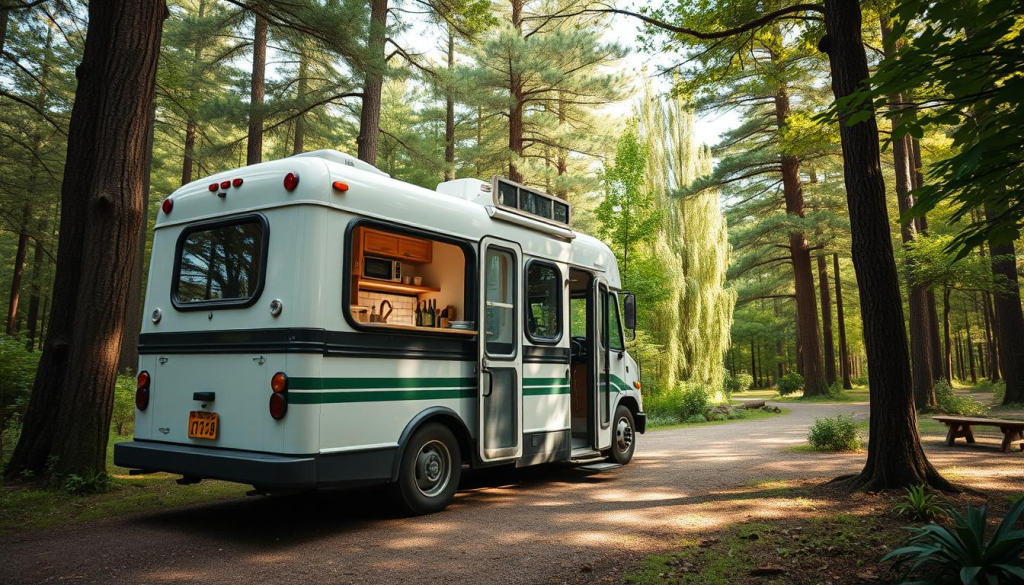
Cost-Effective Living
Another great thing about bus homes is how affordable they are. Buses are often cheaper because schools get rid of old models. This means you can save money on living costs.
Bus homes are a smart choice for those on a budget. They offer a way to live comfortably without spending a lot. Many people have found that living in a bus home saves them a lot of money.
Choosing the Right Bus for Your Tiny House Conversion
Finding the perfect bus for your tiny house is the first step. You need to think about a few important things. The bus’s condition and how well it works are key for a safe and lasting home.
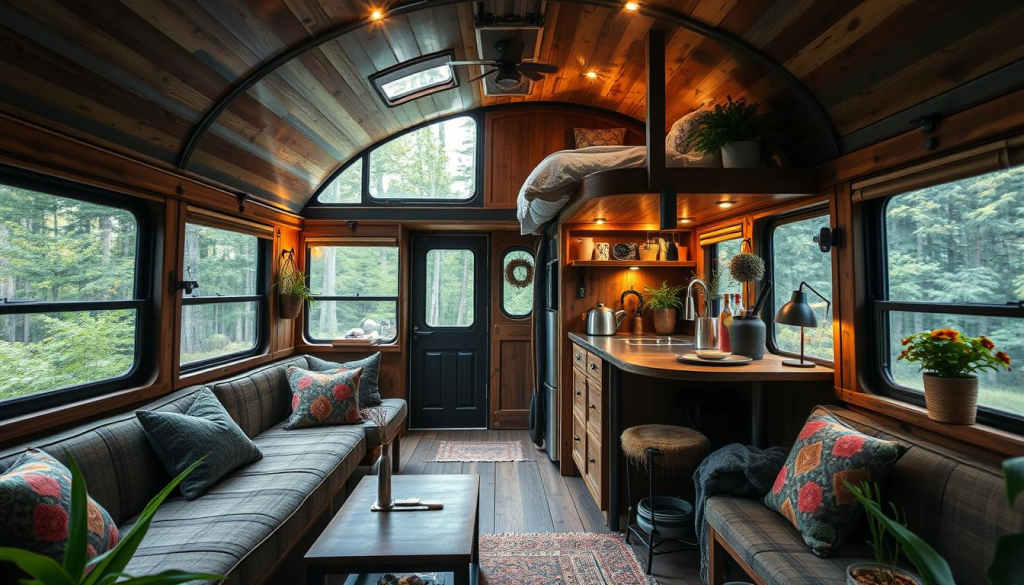
What to Look for in a Bus
When looking at buses, check a few key things:
- Size: The bus’s size affects how much room you’ll have. Shuttle buses are usually 30 feet long and 8 feet wide, giving you more space than some other vehicles.
- Engine Type: Diesel engines are good because they last long and use less fuel. This is great for long trips.
- Structural Integrity: Make sure the bus’s frame and body are rust-free and strong. Rust can cause big problems later on.
- Mechanical Components: Check that the engine, transmission, and brakes work well. Good parts mean safer travel and less money spent on repairs.
- Customisation Potential: Think about how easy it is to change the bus to fit your plans. Some buses are better for making into tiny houses than others.
Where to Buy a Bus
There are many places to find a bus for your tiny house:
- Online Auctions: Sites like eBay have retired buses for sale at good prices. Make sure to check the bus’s history and condition before you bid.
- Direct Purchases: Talking to local schools or transit companies can help you find buses in good shape. They often sell their old buses for a fair price.
- Specialised Dealers: Companies that sell retired buses usually offer warranties and inspections. This can give you confidence if you’re new to buying buses.
Always do a detailed check before buying a bus. Try to see the bus in person and consider getting a mechanic’s opinion. With the right bus, your tiny house dream can come true, leading to an amazing tiny living experience.
Planning Your Tiny House Bus Layout
Starting a bus home design project needs careful planning, especially in small spaces. It’s crucial to create a layout that uses space well. Here are some key points to consider for a layout that suits your needs.
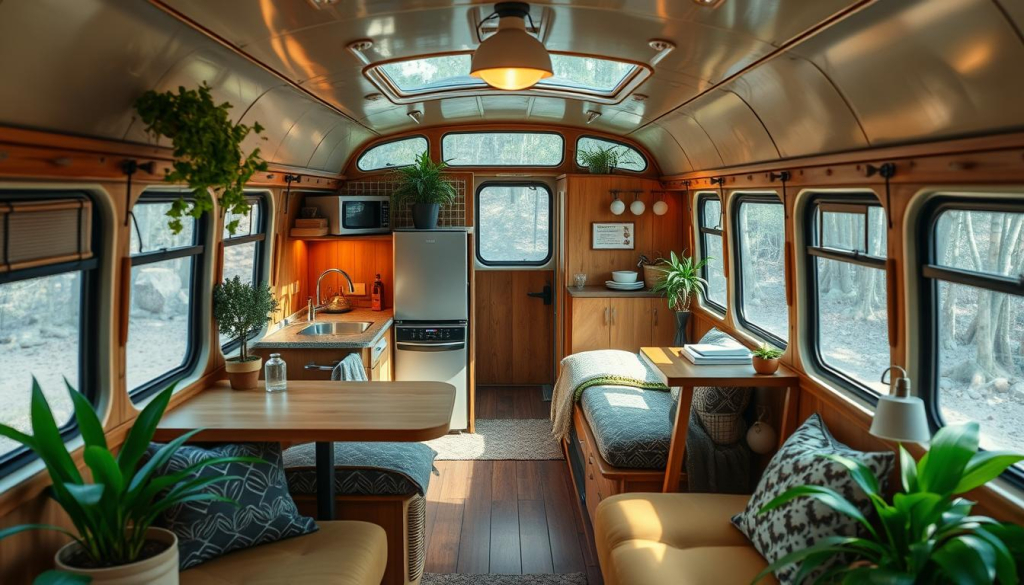
First, list the must-have areas for your tiny home. You’ll likely need:
- Sleeping quarters: A full-size bed is a good choice. You can also use the space under the bed for storage.
- Kitchen: Think about using an old Ikea dresser as a counter. A chest freezer can act as a fridge, saving energy and space.
- Bathroom: Putting the toilet on a wheel well can save space.
- Living area: You can choose a custom couch or an Ikea one with storage.
Being efficient is vital in small spaces. Using furniture that does more than one thing helps use every inch. Breaking your project into smaller parts and making lists can help you stay focused and do better work. Also, learning from experienced builders can lead to better designs.
Kimberley Mok’s book, “The Modern House Bus: Mobile Tiny House”, is a great resource. It shows 12 different bus conversions. It’s full of ideas for making the most of your space, from off-grid living to smart storage.
Focus on making your bus home functional, not just pretty. Adding lots of storage, like slide-out pantries and shoe cubbies, is key. Also, think about adding special features, like a long bar area for dining and working. This way, you get both beauty and practicality.
Every decision about your layout should fit your lifestyle and be ready for changes. Planning well ensures your small space is comfortable and organised. Taking on such a project can be very rewarding, teaching you to be more confident in facing challenges.
Demolition and Preparation
Starting a tiny house bus project means first tearing down the bus. You need to remove seats, fixtures, and any interior parts. This is the first step towards making your bus renovation ideas come to life.
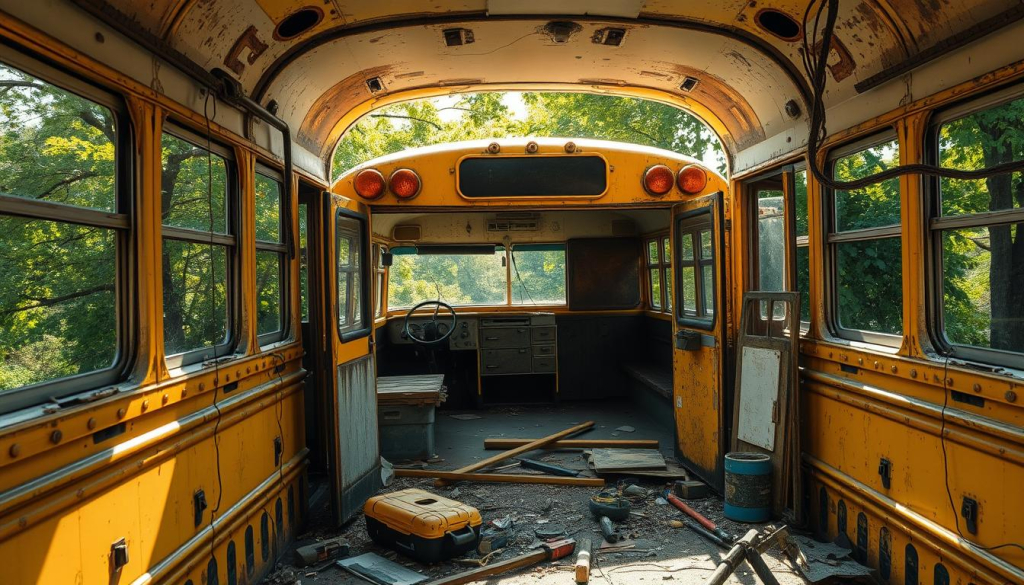
To prepare for the conversion, you’ll need the right tools and safety gear. An angle grinder and power drill are essential for removing seats and flooring. Don’t forget protective gear like safety glasses, gloves, and a mask to protect against rust and dust.
You might find rust or damage to the bus’s structure during this process. Fixing these issues early on is crucial for a safe and reliable base for your tiny house. Removing old materials makes room for the next steps in your conversion.
After demolition, focus on disposing of the removed materials responsibly. Recycling and proper disposal are good for the environment. This step is about starting fresh, ready for the rebuild and customisation that will turn your bus into a home.
Remember these steps as you start converting your bus into a tiny home. Proper preparation makes the renovation smoother and more enjoyable. It ensures your skoolie journey begins well.
Electrical and Plumbing Systems
Setting up a good electrical system and plumbing is crucial for a tiny house bus conversion. We’ll look at the key parts of electrical systems and plumbing and water storage.
Electrical Setup
When planning the electrical system, think about how much power you need. You can use solar panels, generators, or hook-ups. It’s important to be efficient and safe.
- Solar Panels: Using solar energy is a green choice. Experts say a 400-watt system is enough for basic needs.
- Generators: Generators are a good backup for electricity when you’re off the grid.
- Standard Hook-Ups: Connecting to shore power at campsites or RV parks keeps everything running smoothly.
Consider the bus’s power needs, like lights, heating, and appliances. Good wiring and batteries are key to avoiding overloads and having power when you need it.
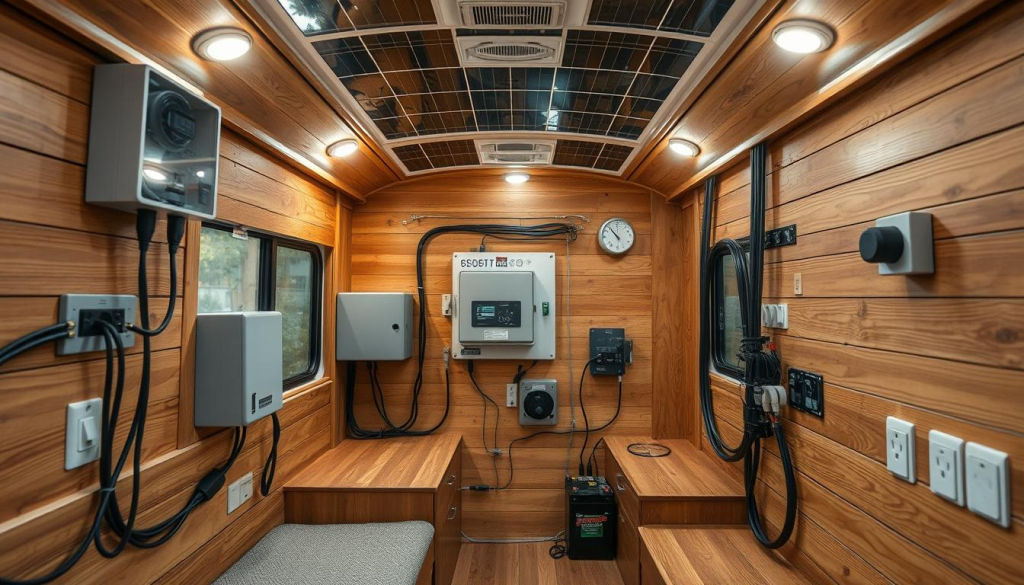
Plumbing and Water Storage
Creating a good plumbing and water system starts with knowing how much water you use. Freshwater tanks, usually 33 to 40 gallons, should meet your daily needs without being too heavy.
- Freshwater Tanks: Choose durable, light tanks. A 100-gallon tank weighs about 834 lbs.
- Plumbing Fixtures: Get essential items like showers, toilets, and sinks. Use water-saving fixtures for better sustainability and comfort.
- Water Heating Solutions: Tankless or solar water heaters are great for endless hot water without the extra weight.
Place pipes and tanks wisely to save space and balance. Use a detailed plumbing plan with elbows and connectors for turns. This ensures a secure and leak-free setup.
For long-term use, keep an eye on your plumbing system. Use top-quality materials and check for leaks or wear regularly. This keeps your tiny house bus reliable and comfortable.
Insulation and Climate Control
Turning a bus into a cosy home needs good insulation and climate control. Choosing the right insulation materials boosts comfort and saves energy. It also improves air quality.
Sheep’s wool is a top pick for insulation. It’s eco-friendly, has a high R-value, and filters toxins. It’s also affordable and easy to work with in bus conversions.
Other materials like spray foam are also effective. Though pricier, it’s very good at keeping warm or cool. But, it must be applied carefully to avoid health risks.
Fibre glass insulation is good for mobile homes. Yet, it can grow mould when wet. Still, it’s often chosen for its low cost and easy availability.
Insulating floors, walls, and ceilings well is key. They should have R-values of R13 for walls and R25 for floors. This keeps the inside warm or cool, no matter the outside weather.
Using heating and cooling systems is also crucial. They help control moisture and keep the air fresh. This is especially important in a bus.
It’s vital to prevent moisture from getting in. Dehumidifiers and dry heat sources help keep the air nice and dry. This makes the bus a comfortable place to be.
Choosing insulation and climate control depends on how you’ll use the bus. Think about the weather it will face. This way, you can make your bus home efficient and comfy.
Interior Finishing Touches
As you near the end of your tiny house bus conversion, the interior finishing touches are where you can truly make your mark. These details are crucial for achieving a balance between aesthetics and functionality—essential for maximising small interiors. When it comes to personalised interior design, consider these key elements:
- Colour Scheme: A monochrome colour scheme, similar to Chay Denne’s conversion, can give a sense of space, making small interiors feel larger. Opt for lighter shades to enhance natural light.
- Materials and Finishes: Using high-quality materials like marble-effect flooring and environmentally friendly options can add a touch of luxury. Ruth and Guy Wimpory’s choice of sheep’s wool insulation not only provided effective climate control but also underscored sustainability.
- Multi-functional Decor: Maximising small interiors is about making each piece of decoration serve multiple purposes. For example, tiny home decor that doubles as storage or can be compacted when not in use adds both function and style.
- Natural Light: Utilising natural light effectively can transform tiny home spaces. Ensure that windows are unobstructed and mirrors are strategically placed to reflect light throughout the interior.
- Secure Furniture: Given that your tiny home on wheels will be mobile, ensure all furniture is securely fastened to avoid movement during travel. Removable or foldable furnishings can also be a wise choice.
Adopting these personalised design techniques can help you in maximising small interiors and ensuring your tiny home bus combines style with practicality as you embark on your journey.
Conclusion
Starting a journey to turn a bus into a tiny home is exciting. It shows a love for tiny living and different living spaces. Our guide shows the ups and downs of this adventure.
The main draw is the freedom and cost savings. You can make the space just how you like it. This makes it a unique choice for many.
We’ve covered everything from picking the right bus to dealing with electrical and plumbing. We’ve talked about using solar panels and composting toilets. These steps are key to making a home that’s off the grid.
Changing a bus into a home means more than just fixing it up. You also need to follow rules and make sure it’s safe. This includes registering it as an RV.
It’s important to keep a detailed record of your work. This will help with registration and checks. Turning a bus into a home shows you’re brave, creative, and care about the planet.
We hope our guide has given you the tools and ideas you need. It’s a big decision, but it could lead to a fulfilling life. Whether you want to travel freely or live simply, a bus home could be the answer.


